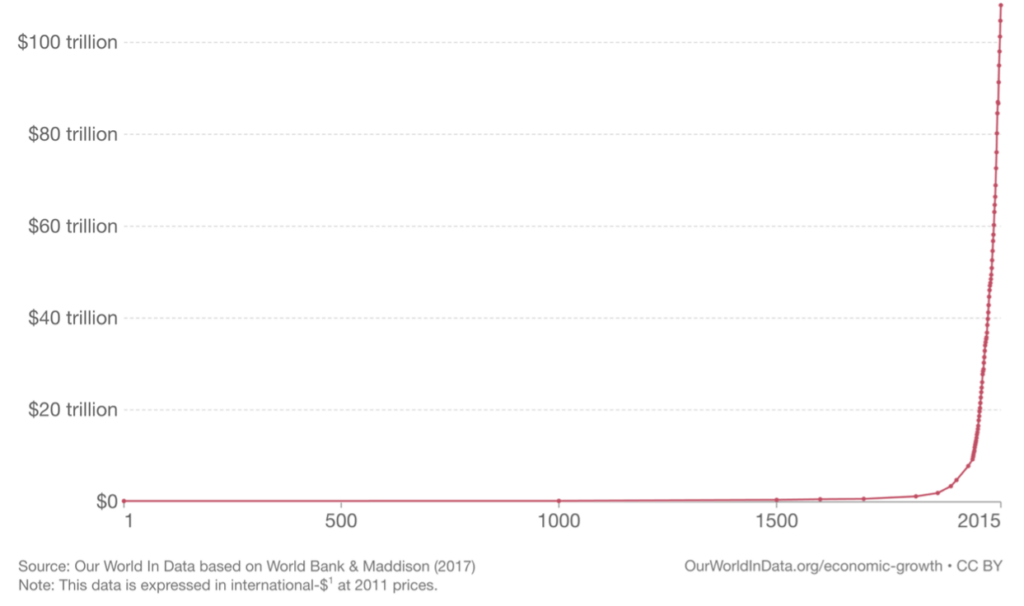How AI will unleash an innovation revolution

Creative destruction celebrates the idea that innovations can destroy the very things they replace — but ultimately have a positive impact on economies and society.
Critics fear that artificial intelligence and emerging technologies will eliminate jobs and entire industries. Philippe Aghion argues in The Power of Creative Destruction that such technological advances have been the engine of U.S. prosperity and may be the key to medical discoveries, a greener planet and other innovations we cannot even imagine. In this article, we will study how technology revolutions evolve, which will inform how AI is likely to progress.
Does automation really eliminate jobs?
Consider the example of the adoption of the iPhone. The device has an impressive array of features, including taking professional-grade photographs. Entire industries, namely film production and photo processing services, have been almost entirely eliminated. In this example of creative destruction, GDP declined, but the quality of life improved, as what we used to pay and wait days for is now free and immediate.
In the case of photography, low-paying photo processing jobs were lost, but most of them were replaced by engineering and software jobs, as well as low-skilled roles that support iPhone production. Innovators are proven to accelerate the skills acquisition of non-skilled workers in their ecosystem faster than non-innovating companies.i Apple, now tooled with superior technology, can expand into other products and build tremendous economic value.
Automation does not eliminate jobs — it redirects them. Research by Aghion shows that a 1% increase in automation within a plant results in .25 more jobs in one year on average, and .4% more in ten years.ii Automations (and the revolutions that enable them) create more jobs than they destroy.
According to Zippia, less than 300,000 jobs have been lost to automation in the U.S. since 2000, representing 2% of the manufacturing workforce. But the process of job destruction replaced by job creation is unsettling when we can’t yet see the new jobs produced. Creative destruction forces low-skilled workers to re-skill. The paranoia about job loss gets to the heart of why we’re feeling vulnerable about AI.
How innovations evolve
Each wave of creative destruction has built upon the last.
Technology revolutions have come in waves, such as the steam engine, the invention of electricity, and the digital revolution. It’s important to note that revolutions lag behind the inventions that preceded them. Electricity was discovered in the 1700s. Thomas Edison invented the light bulb in 1879, but the impact of electricity was not felt until well after 1900.
Once economies cross the chasm and adopt a certain technology, there is a catchup phase where governments and companies implement change very quickly. A current example would be states trying to catch up by providing electric vehicle infrastructure, which is sponsored by the government. EV charging stations are a secondary technology to electric vehicle production, which had a 55% unit increase in 2022, in a market that declined 8%. There is a lag in the deployment of supporting technologies.
Enter GPTs
When technologies are deployed, they are first offered as “general purpose technologies.” These are such broad technologies that they can be applied across multiple industries and functions. Sound familiar? ChatGPT is the first broadly adopted AI technology because it was the easiest to deploy at scale.
It’s the second wave of GPTs that adapts to various sectors of an economy. These innovations take time. Even if AI accelerates the adoption of AI itself, it will be years before we understand the applications of AI to various industries. So let’s slow our roll.
In a way that electric power replaced steam power, entire industries are about to be extinguished. As Clayton Christensen taught us, what we refer to as disruption does not happen by the initial invention of a product. After initial adoption, there is a capital investment into automation to reduce costs. Disruption occurs when we achieve widescale adoption. It was not the Tesla Roadster, released in 2008, that was the disruptor. Last year, the Tesla Y and Model 3 were both in the top 15 selling cars in America, and they are disrupting at scale.
Machines replacing humans is not a new idea. Why are we so threatened by robots replacing humans, when we have no problem with other machines that replace labor? I don’t get worked up when the trash man uses a mechanical arm to lift my trash cans on Monday mornings.
The net effect of automation is more efficiency and lower prices that allow a company like Tesla to scale and create more economic output. This is what economists refer to as the “productivity effect.” Why are we not debating the new jobs that will be created by AI?
History reveals shocking insight into growth
According to illuminating research by Angus Maddison, per capita GDP didn’t grow at all between 1 and 1000 CE. Per capita GDP then grew 58% from the year 1000 CE to 1820, a growth rate of .05% over 820 years.iii
The early 1800s brought the industrial age, first through the rise of the United Kingdom and France, and later the U.S. During the 20th century, the U.S. grew by 24x. The only thing that really slowed down the U.S. economy was its size — the more mature an economy, the slower it grows.
2,000 years of GDP growth

Why did GDP increase so dramatically during the Industrial Revolution?
- In the 17th century, 30% of people died before the age of 30. Life expectancy rose steeply with the advent of penicillin and medical science. A demographic explosion created a “scale effect.”
- The rise of commercial banks, financing and access to capital spurred investment.
- Urbanization: The advent of cities created commerce hubs and cultural centers. Technology catchup is accelerated when there is access to adjacent technologies and proximity to institutions (such as commercial banks).
- The study of economics revealed the most efficient variables to support production.
- The UK government recognized and protected individual property rights as an arbiter of value.
- Fair trade policies limited the ability of monopolists to stifle competition.
- Sparked by a wave of innovations in the decade following the Civil War, the U.S. rose to become an industrial power.
Creative destruction is the accumulation of innovations sparked by competition, incented by governments that protect property rights, in an environment where innovators operate unfettered by artificial barriers from incumbents. The U.S. has been the host of creative destruction in the past. The acceleration of AI is dependent on the prevalence of these conditions.
Want to be afraid?
Now consider the flipside. When economies or companies do not innovate and rely on copying others, they create an “eviction effect” — they eliminate jobs because they cannot compete. So if you want to be afraid about the future, worry that the U.S. is not first to the party when it comes to AI. Or, that your company is not in a position to take advantage of it. Every company has a choice — you can master AI, or you can compete with it.
Creative destruction will come slowly, and then very quickly.
References
i The Power of Creative Destruction by Philippe Aghion
ii The Power of Creative Destruction by Philippe Aghion
iii The Power of Creative Destruction by Philippe Aghion
Related Resources
Artificial Intelligence Resource Center
Artificial intelligence roundtable: Best practices for small businesses [Webinar on demand]
Category : Technology
Topics : artificial intelligence, Innovation Insights, technology trends affecting business
